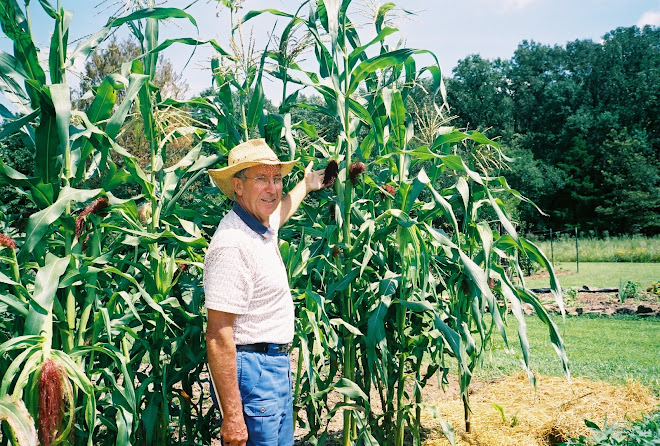So who is "Myc?" He is, or should be, your best gardening and landscaping friend. This is especially true if you are concerned about healthy trees and shrubs. "Myc" is short for the mycorrhizae, (mike-or-eye-z) fungi. The word "mycorrhizae" is from the Greek and means "fungus-root." In short, it is a symbiotic relationship between the plant roots and the fungi. In return for the exudates from the plant roots, mycorrhizal fungi seek out water and nutrients and bring them back to the plant. Neither can survive well without the other. An acre of healthy soil should contain a few thousand pounds of this fungus. What a great working relationship and what an amazing, wonderful natural system.
Mycorrihzae have been known since 1885, when German scientist Albert Frank compared pines grown in sterilized soil and those grown in sterilized soil but inoculated with forest fungi. Those with the fungi grew much faster and larger. We now know that more than 90 percent of all plants develop mycorrhizae, and only perform at their best when they are present. Clearly, fungicides and other pesticides, high salt inorganic fertilizers, and soil disturbances like roto-tilling destroy the fungal hyphae (the thread-like network of the fungi that you see in leaves and decaying wood chips).
The primary function of fungi is to break down organic matter in the soil. They are first rate decomposers, even better than bacteria. The enzymes that the fungi release allow them to penetrate not only the lignin and cellulose in plants (dead or alive) but hard chitin shells of insects and the bones of animals. The enzymes produced by fungi are decidedly acidic and can contribute to lowering of the soil pH. It is important to remember that they are living off plant root exudates, and it is the plant (through the production of the root exudates) that is in control. In the process of doing all this, the mycorrhizae move water and nutrients into the plant.
Mycorrhizal fungi are of two kinds. The first, ectomycorrhizal fungi, grow close to the root surface of roots and can form webs around them. This type is associated with hardwood trees and conifers. The second type,
endomycorrhizal fungi, actually penetrate and grow inside the roots, as well as extend outward into the soil. This type is preferred by most vegetables, annuals, grass, and shrubs. Both types increase the effective surface area of the plant's roots, from 10 to 100 times.
Mycorrhizae are very important in bringing phosphorus to the plant. The acid produced by the fungi can unlock, retrieve, and transport chemically locked-up phosphorus back to the plant. They can also free up copper, calcium, magnesium, zinc, and iron for plant use.
Mycorrhizae can be considered mineral storage facilities. They begin by breaking down organic matter, transporting the minerals to where they are needed, and leaving a storehouse full of reserves when they die. This is the way it works in Nature, and will work for us if we are not abusive to our soils with pesticide toxins and chemical fertilizers. For soils that have been poisoned with toxins, it is fungi, bacteria, and other soil organisms that can restore those soils. Just as they breakdown organic matter, they can breakdown the toxins. But why give them this added burden, if not necessary.
Is there anything I can do to increase the bacteria and fungi in my garden, orchard, and landscape trees? Yes indeed. First, you can change the cultural things you are doing. Remember, you want both bacteria and fungi in each situation. But, you want higher bacterial populations in the garden and higher fungal populations for the orchard and landscape trees. In the garden, the fungi:bacteria ratio should be at the 1:2 level; for the trees it should be at the 10:1 or greater level.
For the garden with a high bacterial requirement, follow these guidelines:
1. Slowly build the organic matter in the soil to 5 percent. Good compost will help.
2. Get the mineral ratios in the soil corrected.
3. Keep the soil in a crop, cover crop, or mulch at all times.
4. Avoid using anything toxic – pesticides, high salt chemical fertilizers, and even chlorinated water.
5. For better aeration, use raised beds.
6. Till as little as possible. No roto-tilling.
For the orchard and landscape trees, which require a high fungal population, follow these guidelines.
1. Slowly build organic matter to 5 percent.
2. Get the mineral ratios in the soil corrected.
3. Use some wood chips for mulch. A couple inches will do. Keep it away from the tree trunk.
4. Avoid using anything toxic on the soil.
5. Avoid situations where you will have drainage problems. Drain if needed.
6. No tilling. In addition to destroying fungi, you will tear up tree roots.
A second important improvement technique is simply to add fungi and bacteria inocula directly to your soil. Many landscapers are now adding mycorrhizal fungi as they plant shrubs and trees. These bacteria and fungi are available from many sources. For the garden, be sure you have a good mixture of bacterial and fungal species. For trees, look for sources that contain several species of the endo- and ectomychorrizal fungi types.
Severely abused, disturbed and polluted soils are the ones that will benefit most from the added inocula products. Whatever microbes you apply are not likely to hurt the soil. The plant and many other organisms already in the soil ecosystem will sort out which ones are needed, and the desirable ones will prevail. See the book by Jeff Lowenfels and Wayne Lewis, Teaming with Microbes, as well as the web, for much more detailed information on this subject.

